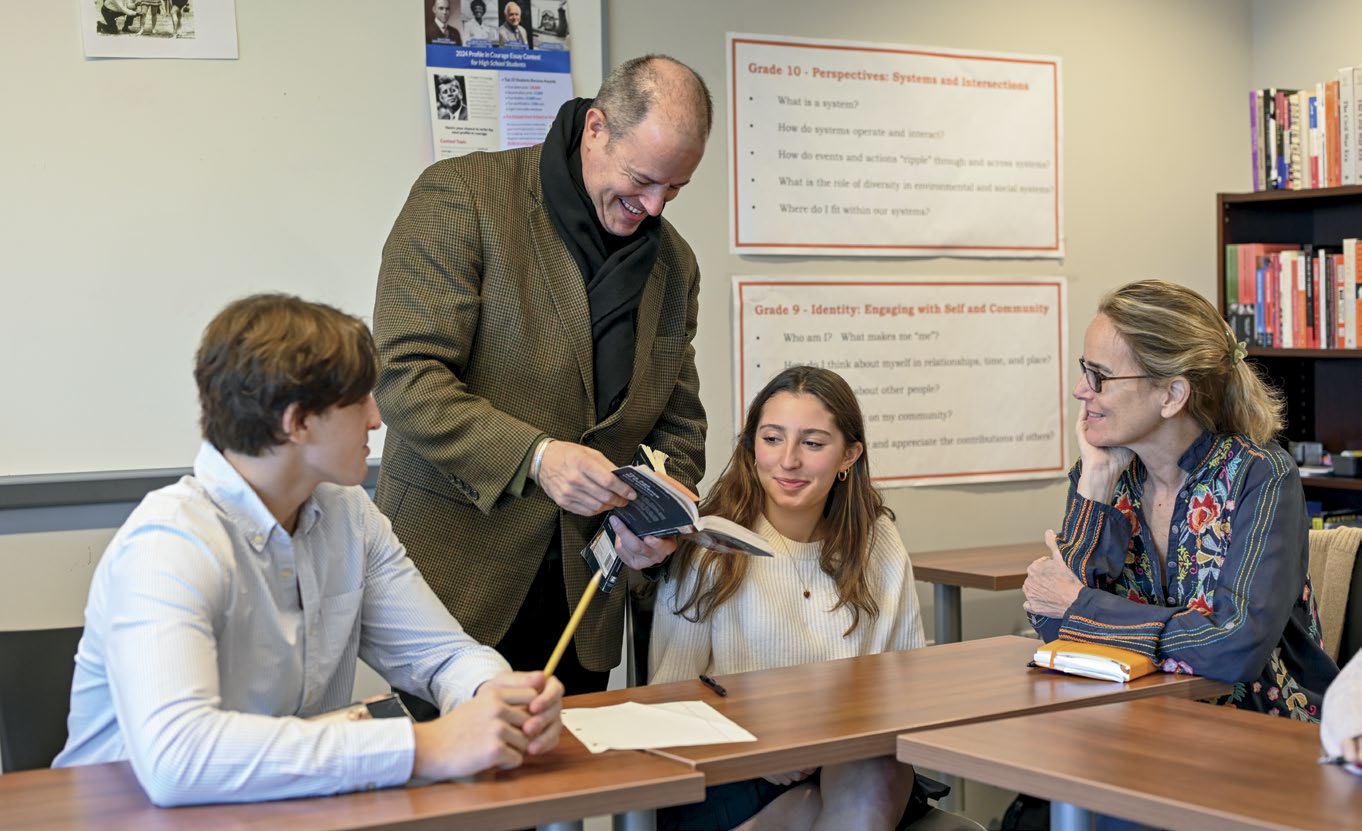
By Dr. Andrew Ruoss, Upper School Academic Dean
As we focus on the acquisition of crucial, college-preparatory skills and knowledge, we also aim to prepare our students to engage with a rapidly changing world and with increasingly complex problems. Collaboration—an essential element of leading university programs and professional fields—is core to these efforts. Over the past two years, we have developed a team-teaching model that demonstrates the real power of our academic culture. It has become a key to how our faculty and students learn, together.
TEAM TEACHING & STUDENT PARTNERSHIP
Step into room 215 and you will enter the world of Word and Image. This team-taught 11th and 12th grade course is cross-listed between our Arts, English, and History departments. Class opens with an animated debate among the three teachers about the meaning of Pip’s ascendance within British society in the Dickens novel Great Expectations. Dr. Louise Wales, Head of the Arts Department and a former professor at Savannah College of Art and Design, focuses on the physical world that defines the character. Dr. Jim Cullen, a prolific historian of American culture, challenges Wales to examine the politics of position. However, their students are not in class only to watch the intellectual exchange of the teachers. Just as Dr. Gregory Grene, an English teacher and a former professor at Columbia Teachers College, prepares to jump in, a student interjects: “but there’s a passage here that works against both of your thoughts. . . .” Three more students dive into the fray, engaging their teachers in the analysis.
Word and Image is one of an array of team-taught courses launched over the past two years in an effort to focus on depth, interdisciplinarity, and application in the Upper School curriculum. We have developed a team-teaching model that demonstrates the real power of our academic culture: faculty and students debating a topic, listening to new ideas, challenging a conclusion, and mapping their thoughts. This culture has an intangible energy, but it has also been built with intention.
In the Upper School, partnership between students and faculty means analyzing ideas, wrestling with contradiction, and navigating disagreement. The three teachers, each an expert in a different discipline, push the students to analyze artifacts, works of literature, and historical patterns from multiple dimensions.
“This approach implicitly encourages students to think from a more interdisciplinary perspective,” argues Dr. Cullen.
With an Upper School faculty recruited from universities, the professional world, and leading independent schools across the country, students witness their teachers model intellectual exchange around complex problems.
“They see us disagree and negotiate with each other, complement each other, and learn from each other,” Dr. Wales adds. The key, however, is that the students also actively engage in the conversation. Students and teachers then start to push each other toward new ways of thinking.
CSX is one of several engineering courses taught across the Computer Science, Physics, and Math programs and another example of a team-taught class. In a recent CSX project, students and teachers sought to model the orbital path of different satellites. Through this project, the faculty team demonstrated how they partner with their students. The teachers led instruction of core skills, but they also guided the class into new territory of complex modeling. This is only possible because each of the three faculty members serves as a practitioner of their branch of engineering, and each teacher comes to the table to learn—from their colleagues and from their students.
In the spring, another team-taught course, Money, Morals, and Mobility, taught by faculty from History, Economics, and English, will be offered as an elective.
This approach represents the Upper School’s broader collaborative faculty culture. “We’re here because we’re learners,” explains Gordie Campbell, Head of the Computer Science Department and member of the CSX teaching team. “I’m constantly auditing the other teachers’ pedagogy—how do they structure questions, respond to student ideas, and manage a project team? It makes me a much better teacher.”
COLLABORATIVE CULTURE IN ACTION: SIGNATURE PROGRAMS
Beyond individual classrooms, this collaborative academic culture also animates the Signature Programs that serve as pathways across the Upper School’s diverse and expansive curriculum.
Every Friday morning, an interdisciplinary team of faculty meets to coordinate our Junior Thesis Program. Through this program, each junior engages in a year-long mentored research project. The Thesis teachers expose their students to research-based writing and presentation from different academic fields. That teaching team then coordinates the entire Upper School faculty to advise the juniors’ projects. This faculty collaboration has an enormous impact on our students’ skill development. Understanding that an engineer, an artist, and an historian will approach the same question differently, juniors learn how to clearly frame their research.
“I am learning how to navigate between different perspectives in order to build my project,” reflects Junior Imran Iftikar, “and I am learning to see how different minds work on the same question.”
Similarly, our Specialized Diploma Programs require students to pursue research questions across their academic classes and to work with an interdisciplinary team of teachers. Dr. Nikki Barratt, an environmental engineer who coordinates our Sustainability Diploma Program, highlights this approach: “All current problems that these students will need to solve are at the intersection of disciplines.” In order to wrestle with this complexity, it is crucial that students have the opportunity to learn with faculty members from different departments. Barratt continues, “approaching real-world problems requires an understanding of data, as well as of the economic, social, artistic, and political implications of potential solutions.” Our Signature Programs guide students to recognize that working with experienced adults to learn how to think across disciplines is, itself, an essential skill.
LOOKING FORWARD
This kind of interdisciplinary, applied learning is also designed to resemble exciting opportunities emerging on college and university campuses. Upper School faculty members focus on preparing students to take advantage of these opportunities. How do you identify what you need to know to solve a problem? How do you learn to work with someone who brings different expertise or a different perspective to a challenge?
Learning within a collaborative academic culture has a profound effect as each senior shapes their vision of the next step in their education journey. Working with the College Office, our seniors are prepared to evaluate the nature of mentorship, teaching, and research offered by different college communities. “I’ve now framed my college search, thinking about where I might be able to build real intellectual relationships with professors,” explains Ruby Cosgrove, a senior in the Word and Image class. “I know what that looks like because I’ve experienced it.”


.jpg&command_2=resize&height_2=85)



.png&command_2=resize&height_2=85)


.jpg&command_2=resize&height_2=85)








.jpg&command_2=resize&height_2=85)



